 Choose your legwear like your life depends on it. 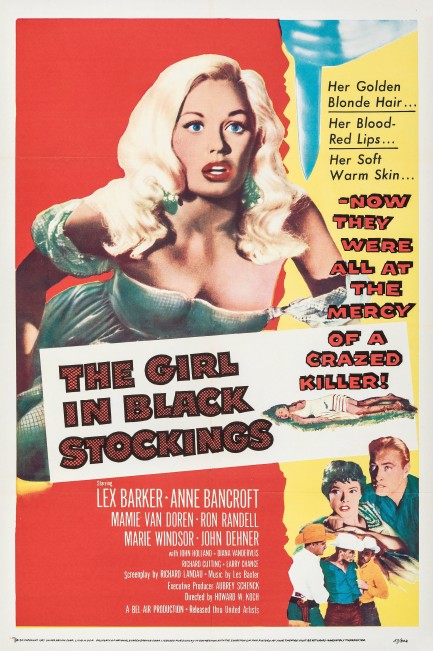
Once again, we have a poster proving that some of the worst movies had some of the best promotional art. This exemplary effort was made for The Girl in Black Stockings, which began its U.S. run today in 1957 after having its world premiere in England earlier in the year. The art showcases Mamie Van Doren, who's third billed but is the big draw. We talked about the movie last year and, shorter version, it's bad but occasionally amusing. By the way, legwear has nothing to do with the murder. The folks at Bel-Air Productions and United Artists knew they had a catchy title and simply ran with it.
 Mamie Van Doren can add value to anything, but even she can't save The Girl in Black Stockings. 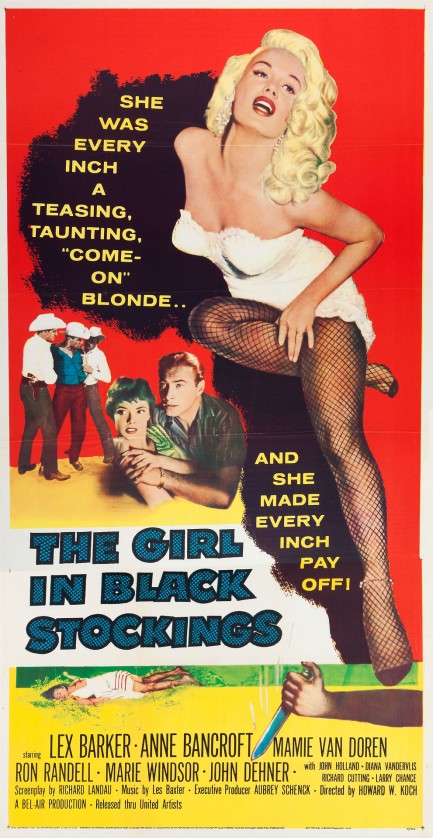
This bright poster was made for the b-drama The Girl in Black Stockings. It had its world premiere in England today in 1957 and, in contrast to the art, is a colorless murder mystery set in and around a lodge hotel in a tiny western U.S. town—the kind of place where, you know, “nothing like this has ever happened before.” Lex Barker stars as a Los Angeles lawyer who goes to this arid little stopover for peace and quiet, but discovers a body that's been mutilated as though by a psychopath. A county official warns, “The type that did this—they don't stop with just one.”
Sure enough, more deaths follow and—as doctors are wont to do—Lex inserts himself right into the middle of the investigation. His professional acumen is needed. There are a lot of suspects. Anne Bancroft as the local beauty, Mamie Van Doren as a stereotypical blonde floozy, Ron Randell as a woman hating lodge owner who's confined to a wheelchair—or is he?—and Marie Windsor as his unhealthily attached spinster sister are all under the suspicious gaze of the plodding but tenacious sheriff John Dehner.
Sadly, the mystery isn't compelling and the dramatic aspects of the narrative are blah because none of the characters are interesting. All the main actors have done well in other movies, but here they're hobbled by a poor script, particularly Randell, who's forced to mouth numerous cynical and self pitying soliloquies. Van Doren, who we feel confident saying cannot act, is also bad here. She has a drunk scene that will make you cringe, it's so wooden.
The end result is a dismissable movie that's only barely remembered because it was shot in Utah, which provides some nice scenery, and because it has Van Doren, who was obviously cast to provide a different type of scenery, and achieves that function with ease. We'll always take a look at any film in which she appears. She's no Marilyn. But she's not far behind. Yet even with her presence and some long looks at the Beehive State, we can't recommend The Girl in Black Stockings.
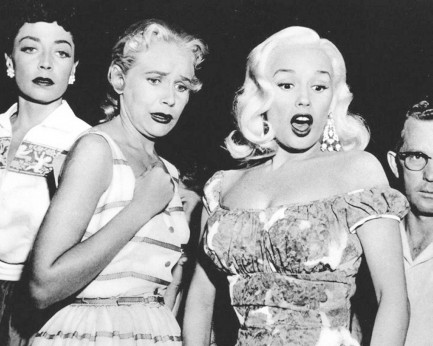 Oh good Lord! She's been murdered and mutilated beyond recognition! Somebody call a doctor! Oh good Lord! She's been murdered and mutilated beyond recognition! Somebody call a doctor!
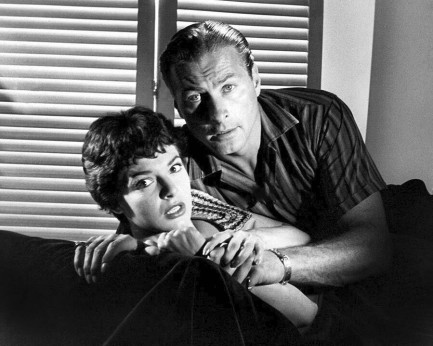 What the..! Don't you knock? I'm in the midst of a consultation here! What the..! Don't you knock? I'm in the midst of a consultation here!
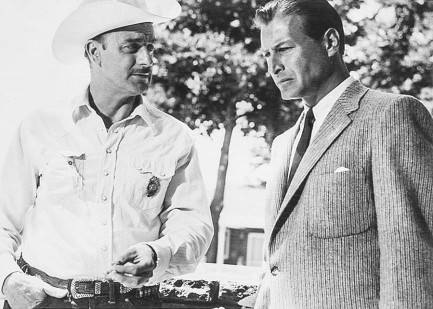 I can advise you only informally until I hear back from the town's insurance network, Sheriff. But you might start with an immediate canvassing effort and a check for similar crimes in the state going back at least ten years. I can advise you only informally until I hear back from the town's insurance network, Sheriff. But you might start with an immediate canvassing effort and a check for similar crimes in the state going back at least ten years.
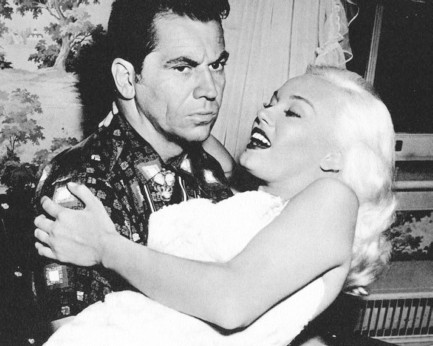 Actually, knowing there's a killer on the loose and any of us could be snuffed out next doesn't make me horny, Diana. But thanks for thinking of me. Actually, knowing there's a killer on the loose and any of us could be snuffed out next doesn't make me horny, Diana. But thanks for thinking of me.
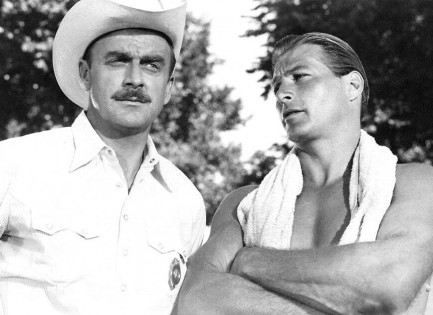 Well, Sheriff, turns out the town has a three murder deductible. I'm afraid my hands are tied until a fourth person is slain. Well, Sheriff, turns out the town has a three murder deductible. I'm afraid my hands are tied until a fourth person is slain.
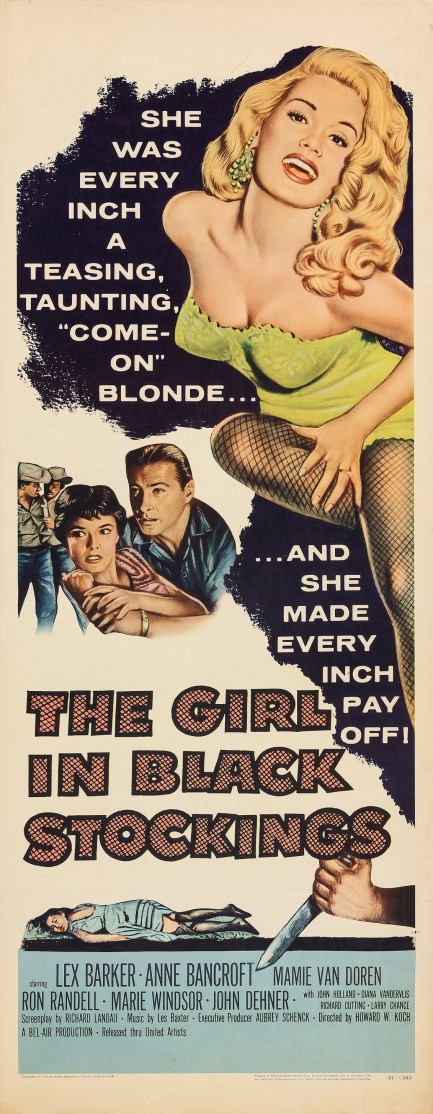
 The film stars a Barker—and that's also a good description of this dog. 
This poster, which you will see when you scroll down is two sided, folded into four panels, was made for Battles of Chief Pontiac, a film starring Lex Barker in a story of war between the French and British over what is now the vicinity of Detroit, Michigan. Within this larger fight, Ottawa tribes mount a resistance against the occupying British and their German, or Hessian, mercenaries. This resistance is seriously hampered after the Ottawa are suckered into a peace parlay, then deliberately given blankets infected with smallpox. Treachery much, paleface? Why, yes, all the time.
Throughout all the battles and betrayals hero Lex Barker—the only noble white character—speaks in a neutral American accent that didn't exist 200 years ago, while the supporting white players do their best evil nazi and pompous Brit dialects. This is a nice little trick, portraying all the bad guys as essentially foreign. Never mind that the U.S. is made up of descendents of those colonists, and Barker's character is a colonist too. In cinematic terms it's a deft, almost subliminal job of blame shifting. That the film also showed overseas, where accents would have been lost on audiences, thus making it play more like a broad indictment of colonial expansionism, is an irony. Until we shared today's poster there was never any indication anywhere online that Battles of Chief Pontiac played in Japan, but the evidence is clear in this butterscotch promo—which is far more artistic than the film. Yes, this Barker vehicle is a total dog. Avoid it, except for its comedy potential—that is, if watching pasty white guys in brown shoe polish is funny. Battles of Chief Pontiac premiered in the U.S. today in 1952, and according to the poster, hit Japan in 1956. You see the right half of the front side, and the entire rear just below.
 It could have been worse. They could have flown United. 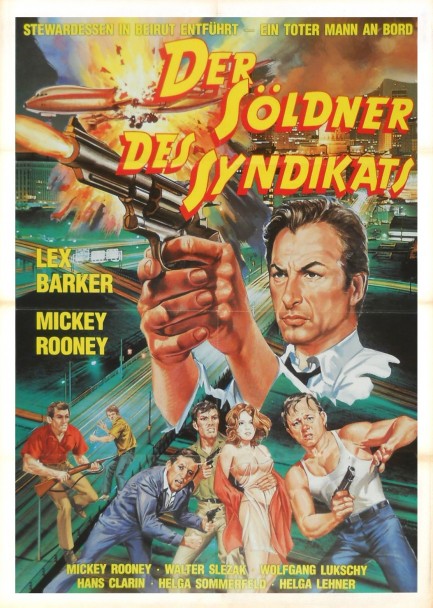
This chaotic West German poster for Der söldner des syndikats caught our eye for a couple of reasons. One was its sheer garishness, and the other was because the unknown artist depicted diminutive Mickey Rooney all swoll up like a Marvel Comics superhero. It just screams cheeseball classic, so we had to check out the film, which is known in English as 24 Hours To Kill. When a plane makes an emergency landing in Beirut the flight crew learns that one of their number (Rooney, decidedly un-swoll and unheroic) is hunted by a criminal smuggling syndicate he's double crossed. The repaired plane leaves in twenty-four hours, and the crew decide to protect Rooney until that time. Abandoning him is out, because he's a pal, and going to the police is out, because they'd be stuck in Beirut for days or weeks, thus making the syndicate's job easier. So the plan is to protect Mickey Louse for a day and then jet—if they can manage it. What follows is a series of botched abductions worthy of Raiders of the Lost Ark, ornamented with location shooting in Byblos, Baalbeck, Casio Du Liban, and a Beirut long since reshaped by war and bulldozed for high rises and privatized resorts. Those locations possibly make the movie worthwhile all on their own, and other beautiful sights are provided by co-stars Helga Sommerfield and France Anglade. A minor ’60s thriller, this one feels like a television movie, which means the level of tension is not nearly high enough. Nor the level of action—there's more on the poster than in the film. But even if the art misleads, the movie is entertaining enough. Made in English by the West German production company Grixflag Films Ltd., Der söldner des syndikats premiered in West Germany today in 1965.
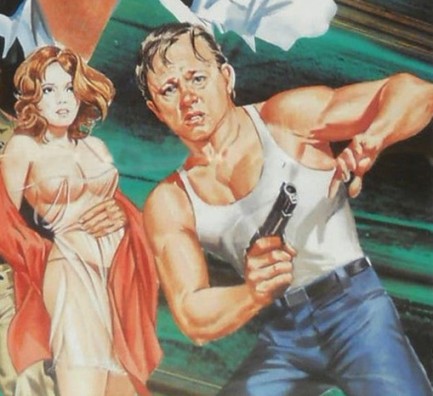 Intimidating movie poster Mickey. Intimidating movie poster Mickey.
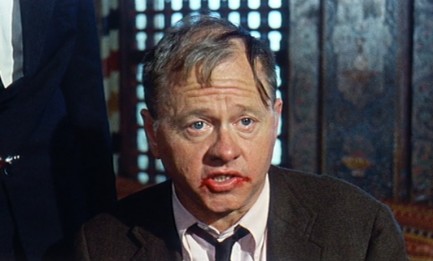 Not very intimidating movie Mickey. Not very intimidating movie Mickey.
 Did she or didn’t she?  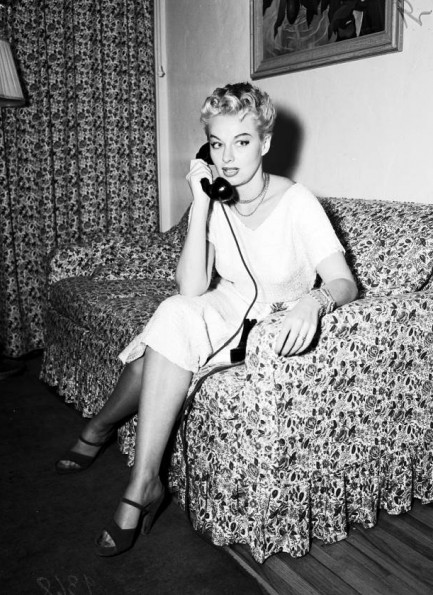
These two photos showing burlesque dancer Lili St. Cyr were shot today in 1951 for a Los Angeles Examiner story about St. Cyr’s legal difficulties. On 23 February of that year she had begun performing at Ciro’s supper club in Hollywood. It was a different type of club for her—it lacked the intimacy of her normal venues, and would sap some of the heat from her act, but the place was world famous and considered by the smart set to be classy. It had hosted Edith Piaf, Marlene Dietrich, Duke Ellington, and Dinah Washington. Of late it was facing stiff competition from Macambo’s, a Brazilian themed joint across the street, and owner Herman Hover wanted to make a splash with St. Cyr. He spent thousands refurbishing the stage just for her, and she would be the first burlesque dancer to transition from men’s clubs to L.A.’s most famous supper club. On premiere night celebs such as Ronald Reagan, Nancy Davis, Franchot Tone, Barbara Payton, Lex Barker, Mickey Rooney, and Los Angeles mayor Fletcher Bowron watched her strip down to toned perfection as they ate dinner and sipped drinks. Other celebs that visited that summer included Bette Davis, Humphrey Bogart, and Clark Gable. During St. Cyr’s residency she varied her act, but a standard bit was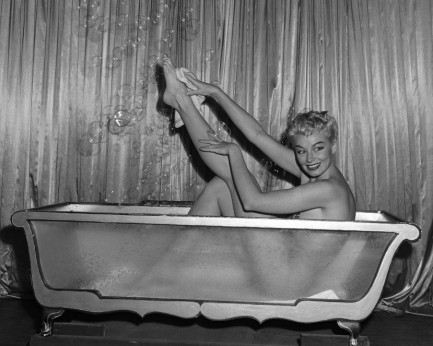 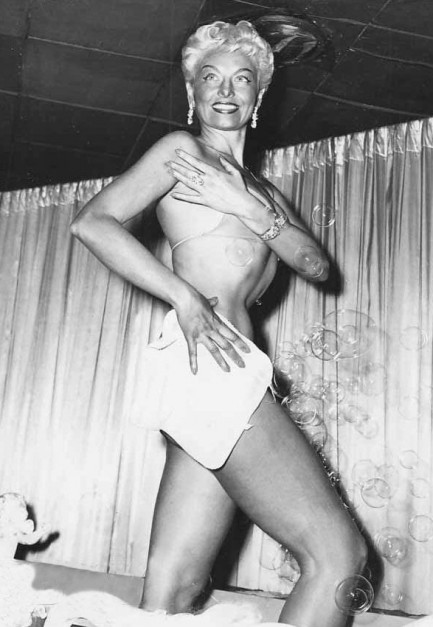 entitled "An Interlude Before Evening," and involved being helped from her clothing by her maid Sadie before slipping nude into a bathtub. But the nudity was an illusion, the cleverest part of her act, achieved through a combination of lighting, positioning, flesh-colored underwear, and sheer athleticism as she slipped quickly from behind a towel and into the sudsy tub. entitled "An Interlude Before Evening," and involved being helped from her clothing by her maid Sadie before slipping nude into a bathtub. But the nudity was an illusion, the cleverest part of her act, achieved through a combination of lighting, positioning, flesh-colored underwear, and sheer athleticism as she slipped quickly from behind a towel and into the sudsy tub. On 18 October a group of Los Angeles sheriff’s deputies, who were trying to enforce a countywide ban against stripping, arrested St. Cyr and Herman Hover. The charges were the usual slate. St. Cyr called upon celebrity lawyer Jerry Giesler—an event the two Examiner photos at top are supposed to be illustrating—and Giesler proceeded to help turn what was already a media boon for St. Cyr into a full bonanza. Giesler was a showman, and he loved cases that had the potential to increase his fame. He made assorted sensational statements to the press, including one in which he promised to have his client perform her bath routine in the courtroom, and another in which he opined that putting together a jury of peers required empaneling a dozen strippers. He described St. Cyr as merely trying to improve her station in life, just an industrious woman trying to carve herself a piece of American pie. The press ate it up. 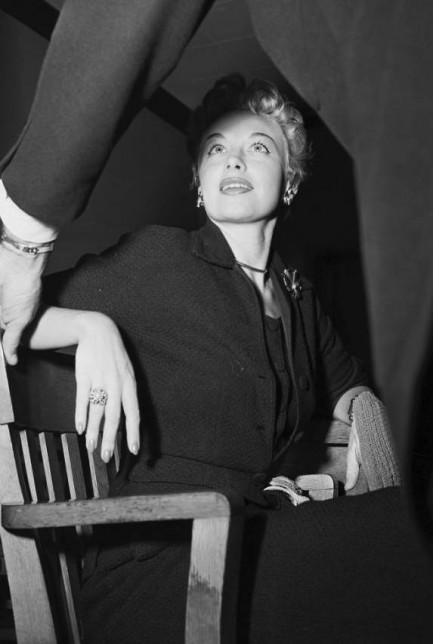 The trial was scheduled for early December in the Beverly Hills Courthouse. Giesler kept the jury—which wasn’t all strippers, but at least was mostly female—laughing with his continual antics. He introduced St. Cyr’s rhinestone encrusted bra and g-string as people’s exhibits A and B. He drew diagrams on a blackboard illustrating how different observers' vantage points toward the stage were blocked by St. Cyr's maid. He flustered police officials by making them discuss in detail such such terms as “bump,” “grind,” and “half-bump,” and followed that up by putting Herman Hover on the witness stand and having him demonstrate those moves. The sight of the portly Hover attempting burlesque sent ripples of laughter through the courtroom. Years later Giesler wrote: “I can honestly say I succeeded in having her case laughed into a not-guilty verdict.” The trial was scheduled for early December in the Beverly Hills Courthouse. Giesler kept the jury—which wasn’t all strippers, but at least was mostly female—laughing with his continual antics. He introduced St. Cyr’s rhinestone encrusted bra and g-string as people’s exhibits A and B. He drew diagrams on a blackboard illustrating how different observers' vantage points toward the stage were blocked by St. Cyr's maid. He flustered police officials by making them discuss in detail such such terms as “bump,” “grind,” and “half-bump,” and followed that up by putting Herman Hover on the witness stand and having him demonstrate those moves. The sight of the portly Hover attempting burlesque sent ripples of laughter through the courtroom. Years later Giesler wrote: “I can honestly say I succeeded in having her case laughed into a not-guilty verdict.” That may have been true, but St Cyr’s icy demeanor was also an important factor. The women found her elegant and remote—the opposite of what they had expected. And the cops did their part for St. Cyr's defense by being terrible witnesses. One claimed that she emerged from the tub completely nude (the normal conclusion to her Interlude, and just as illusory). Another said she wore undies but that he could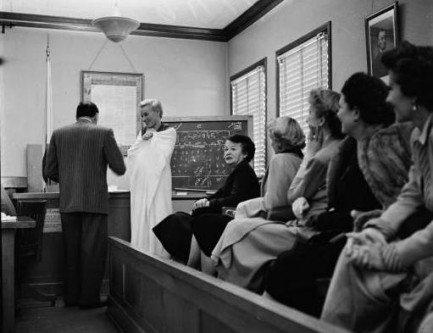 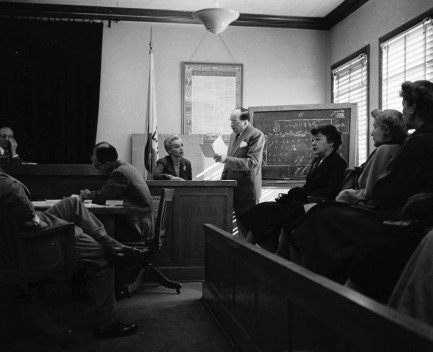 see the outline of her “private parts,” which he discerned in enough detail to determine “were shaven.” The inconsistencies were epic. Some said she caressed herself, others weren’t sure. Another described her towel as “about twenty, twenty-four inches.” In reality it was three times that size. It was as if St. Cyr's dance had dumbfounded the cops. see the outline of her “private parts,” which he discerned in enough detail to determine “were shaven.” The inconsistencies were epic. Some said she caressed herself, others weren’t sure. Another described her towel as “about twenty, twenty-four inches.” In reality it was three times that size. It was as if St. Cyr's dance had dumbfounded the cops. The confusion has extended even to the present day. For a performance that lasted barely fifteen minutes, it has had an amazing amount of conflicting information attached to it. Columnist Army Archerd claimed St. Cyr was indeed nude that night (clearly wrong, according to multiple testimonies); Sheila Weller’s book Dancing at Ciro’s claims an “all-male” jury (it was mostly female) was taken to Ciro’s to see the act (Giesler tried, but the judge said no); some sources claim St. Cyr performed a reverse strip, beginning nude in the tub and emerging to be slowly dressed by her maid (indeed, that was an oft-performed variation, so it is certainly possible it happened that night). Who's right, and who's wrong? Short of using a time machine to return to October 1951 there's no way to tell. At the end of the six-day trial the jury acquitted St. Cyr following a mere seventy-eight minutes of deliberations. There had been no indecent exposure. At least not that night. All St. Cyr’s biographers agree on this much—she was shy and regal offstage, but her performances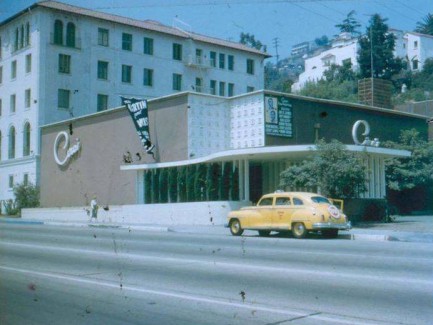 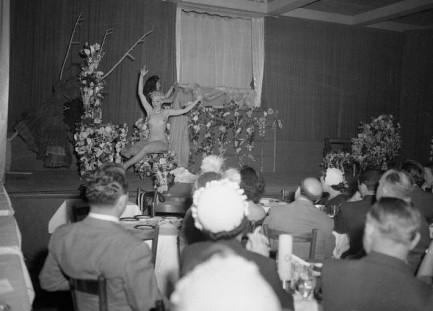 freed her to inhabit different characters. Despite her assertions that she always wore at least a g-string and bra, she definitely performed topless on occasion, as shown by the above photo taken at Ciro’s during early 1951. freed her to inhabit different characters. Despite her assertions that she always wore at least a g-string and bra, she definitely performed topless on occasion, as shown by the above photo taken at Ciro’s during early 1951. Sheriff’s deputies had gone to the club already intent upon arresting her based on what they had heard about the act, which may have influenced their testimony—i.e., they didn’t see her nude, but knew she had done it before. St. Cyr admitted in court she knew police were in the audience, thus she was especially careful that night. But what of other nights? Maybe Army Archerd did what columnists do—took an event he witnessed on one night and pretended it happened on a more useful one. Maybe St. Cyr, on occasions when she knew the cops were far away, flashed her audience to generate buzz. It’s likely we’ll never know what really happened, but that merely adds to the St. Cyr mystique. Did she or didn’t she? Only her maid knew for sure.
 Liberace experiences tabloid wrath at its most merciless. 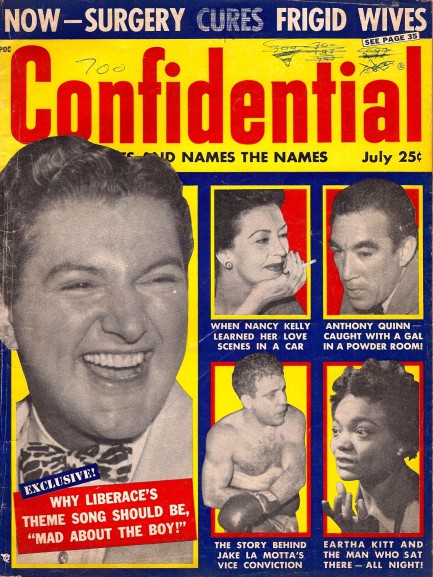
It was in this July 1957 issue of Confidential that journalist “Horton Streete’ infamously outed cover star Liberace in the most vicious and dehumanizing way with an article entitled “Why Liberace’s Theme Song Should Be ‘Mad About the Boy’.” We’ve talked about it before. Streete willfully attempted to damage the singer’s career by spinning a shocking tale of how he attacked a young, male press agent. The article refers to Liberace as Fatso, Pudgy, Dimples, and other, less flattering monikers. Here’s a rule you can count on—when a journalist or on-air personality constantly refers to someone by other than his or her name or title, it’s a hit piece. Liberace was horrified and sued Confidential. California Attorney General Pat Brown had already managed to win an indictment of the magazine two months earlier. Owner Robert Harrison was about to spend his entire summer in court. He took these legal threats to heart and publicly promised to stop publishing stories about the private lives of Hollywood stars. Up until then Confidential had been as reckless as a magazine could be. This issue accuses Gary Crosby of punching a woman in the face, and Eartha Kitt of trapping her friend’s boyfriend in her penthouse. An extraordinary story about boxer Jake LaMotta suggests the he got a bum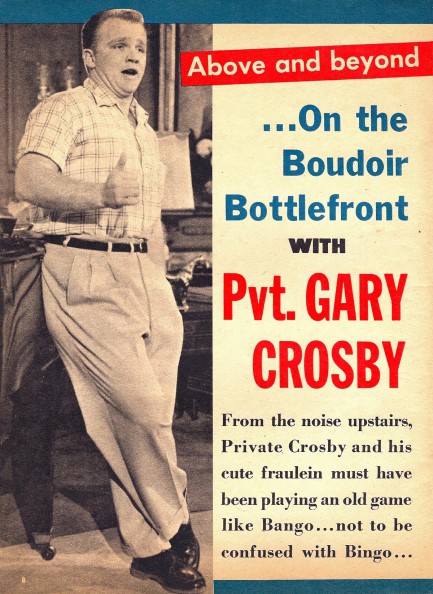 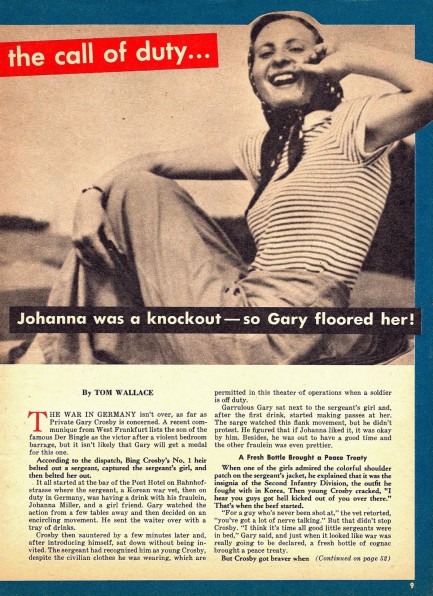 rap in his morals trial. LaMotta was serving time for bedding a 14-year-old. Prosecutors had convinced a jury that the incident with LaMotta was a primary cause of the girl later becoming a prostitute. Confidential rides to the rescue, claiming that the girl’s father had already deflowered her, therefore LaMotta could not have had any influence on the girl’s fate. How’s that for a principled stand? rap in his morals trial. LaMotta was serving time for bedding a 14-year-old. Prosecutors had convinced a jury that the incident with LaMotta was a primary cause of the girl later becoming a prostitute. Confidential rides to the rescue, claiming that the girl’s father had already deflowered her, therefore LaMotta could not have had any influence on the girl’s fate. How’s that for a principled stand? These early issues of Confidential are a cesspool of journalistic ethics, no doubt, but they’re also a visual treat. Using black, red, blue, and yellow, plus the white of the pages themselves, the designers put together a bold and gaudy package that would influence every other tabloid on the market. The layouts on Kitt, Liberace, Alan Dale, and Lex Barker are among the most eye-catching we’ve seen from the period. Elsewhere you get Anthony Quinn, and a host of other stars. We have a bunch of scans below. Remember, you can always see more from Confidential and other tabs by visiting our tabloid index at this link.
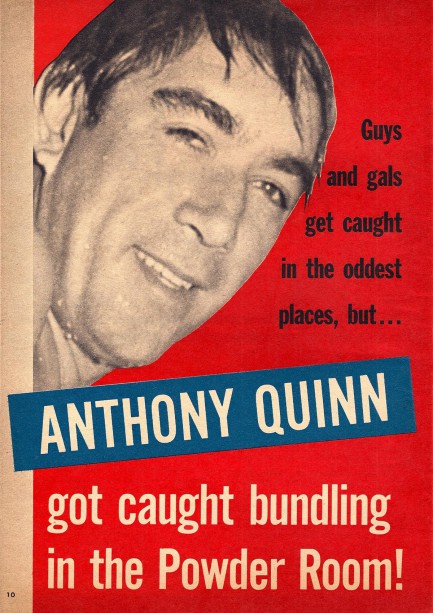 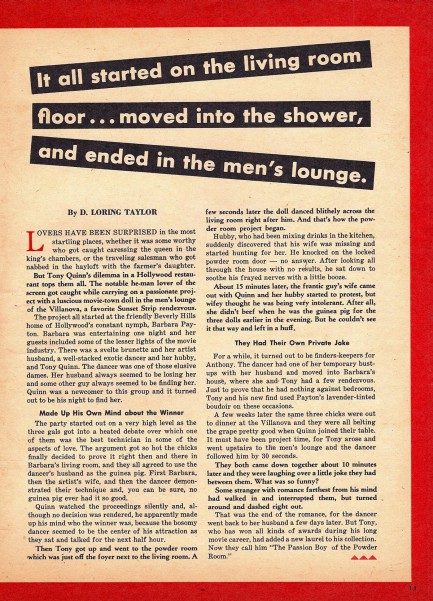 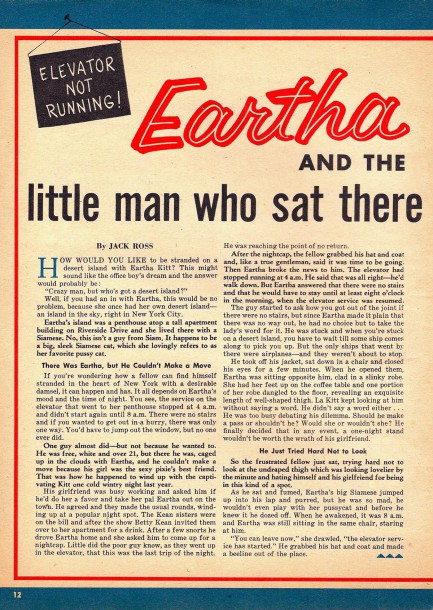 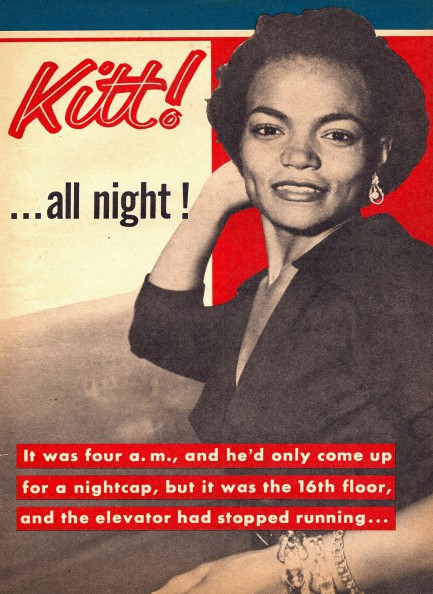 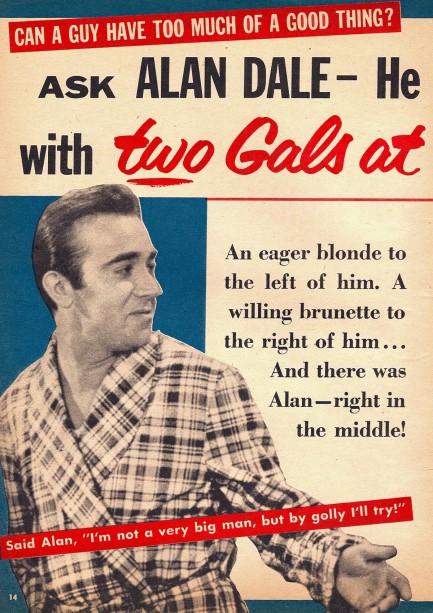 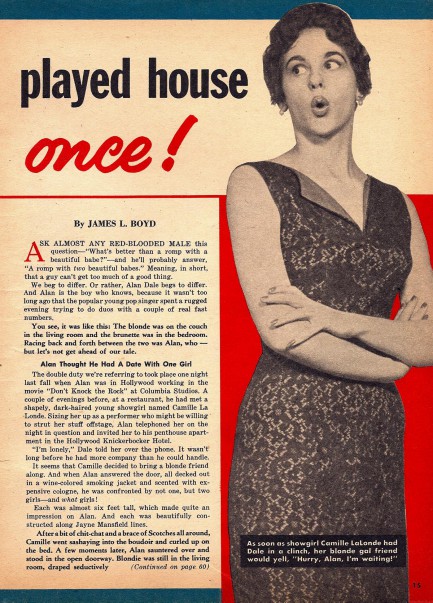 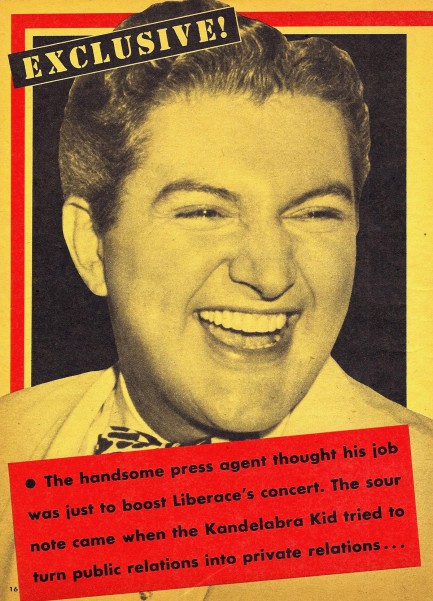 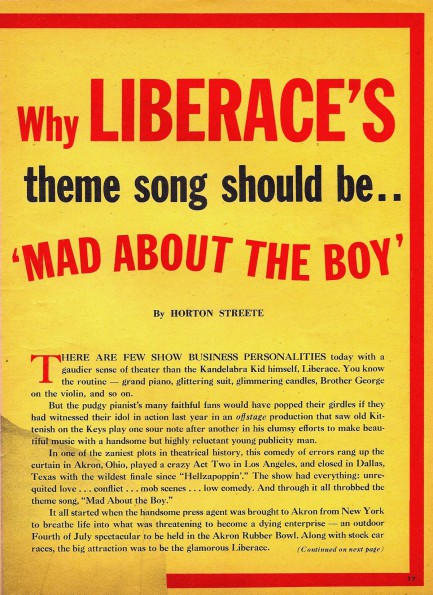 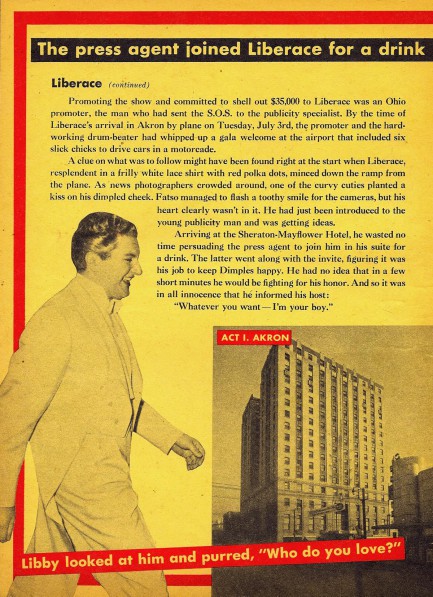 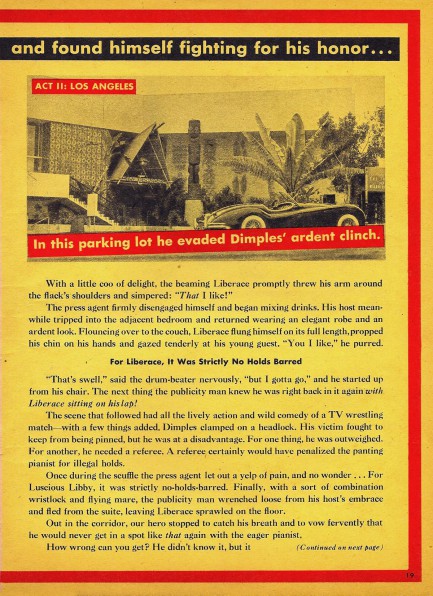 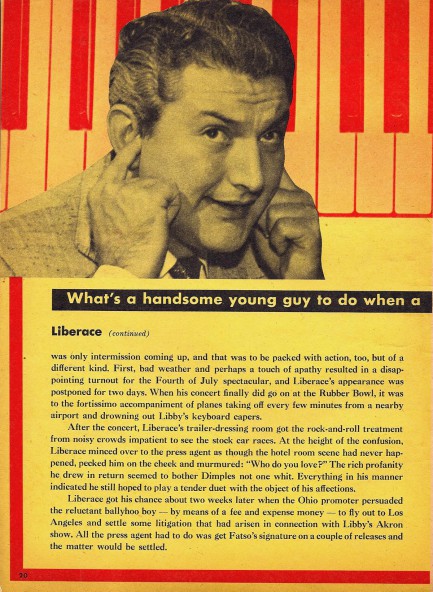 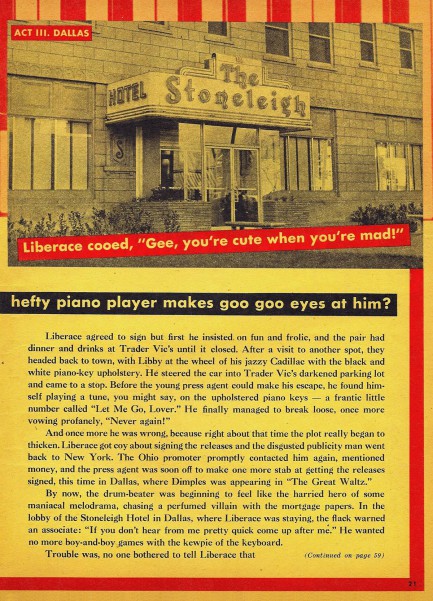 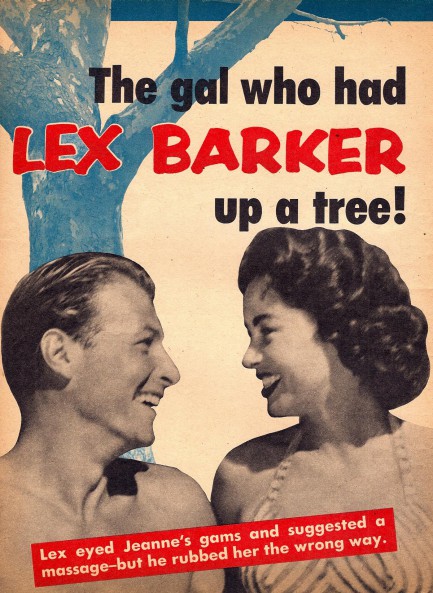 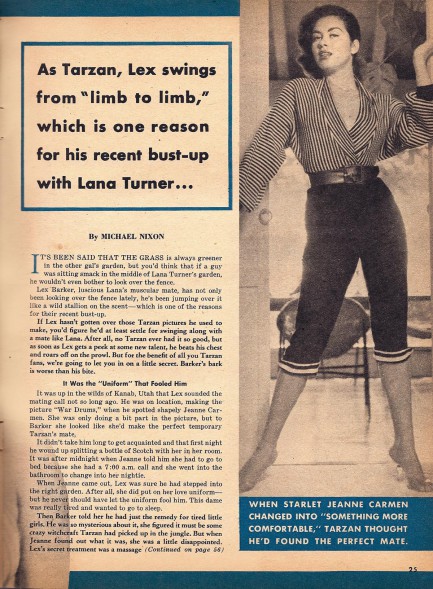 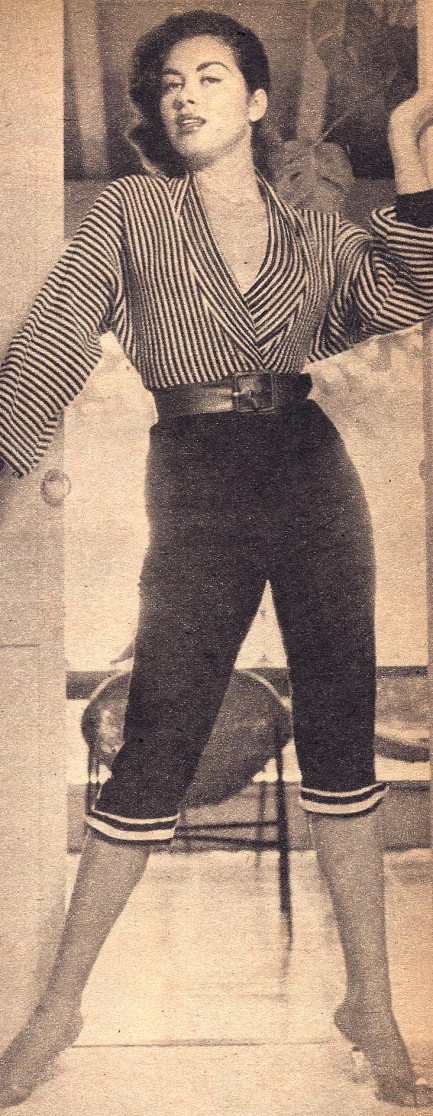 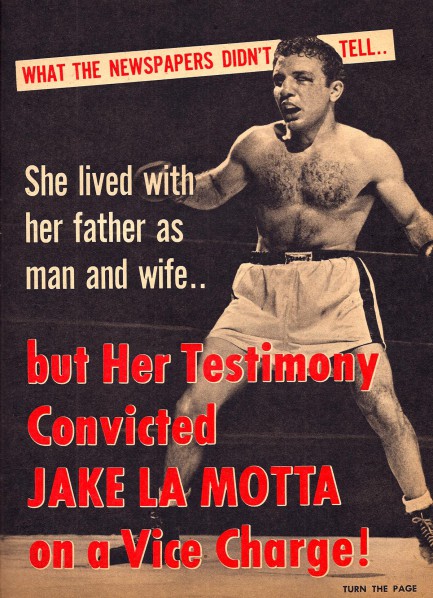 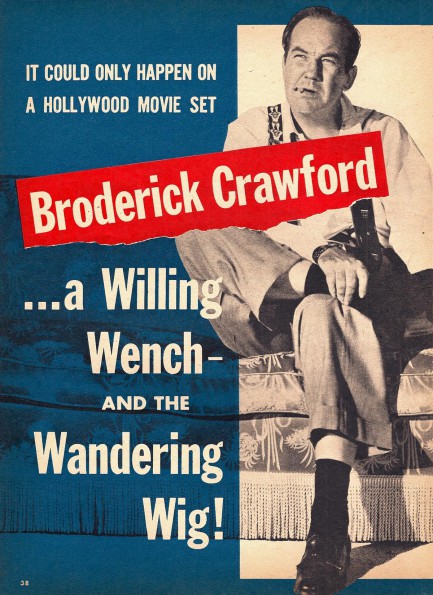 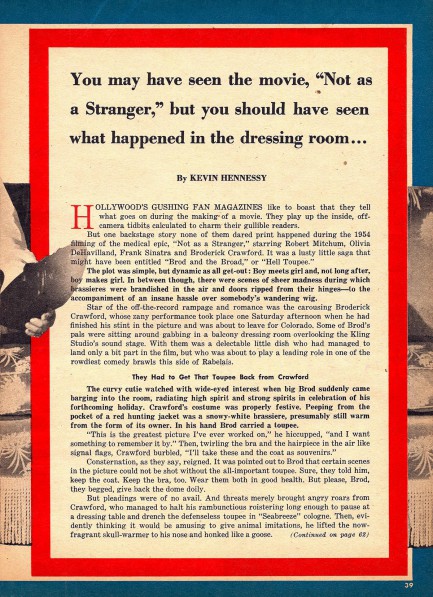 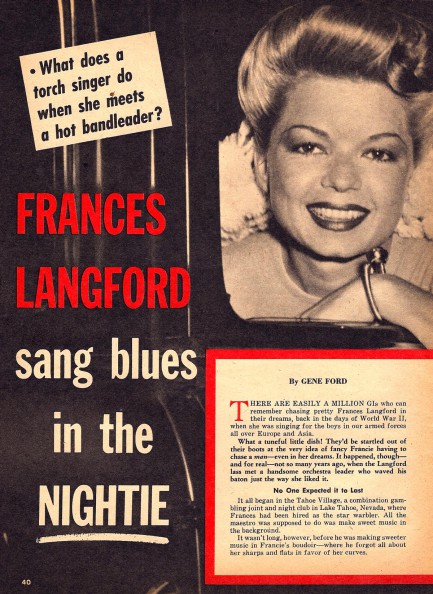 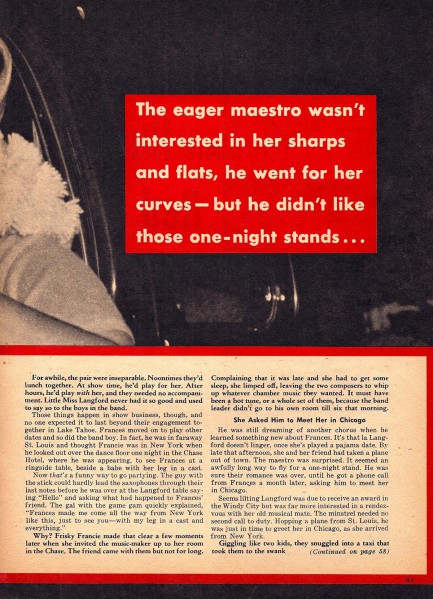
 Has anyone seen my tube of Tannymax? The king-size one? About yay big? 
When we came across this promo shot of a very brown Gordon Scott we had to post it because we remembered him fondly from an especially amusing episode of Mystery Science Theater 3000. Here you see Scott as Tarzan, which was a role he took after Lex Barker moved on to greener pastures. Scott was the twelfth actor to inhabit film’s most famous loincloth, by which time it probably needed a good scrubbing. After six of the jungle adventures, he went on—still impressively bronzed, though wearing slightly more costuming—to headline numerous Italian sword & sandal epics. He also starred in the groovy spy movie Danger!! Death Ray, aka Il raggio infernale, which is the film MST3K skewered. Got ninety spare minutes? Check it out here. Scott was a true b-movie heavyweight.
|
 |

The headlines that mattered yesteryear.
1939—Batman Debuts
In Detective Comics #27, DC Comics publishes its second major superhero, Batman, who becomes one of the most popular comic book characters of all time, and then a popular camp television series starring Adam West, and lastly a multi-million dollar movie franchise starring Michael Keaton, then George Clooney, and finally Christian Bale. 1953—Crick and Watson Publish DNA Results
British scientists James D Watson and Francis Crick publish an article detailing their discovery of the existence and structure of deoxyribonucleic acid, or DNA, in Nature magazine. Their findings answer one of the oldest and most fundamental questions of biology, that of how living things reproduce themselves. 1967—First Space Program Casualty Occurs
Soviet cosmonaut Vladimir Komarov dies in Soyuz 1 when, during re-entry into Earth's atmosphere after more than ten successful orbits, the capsule's main parachute fails to deploy properly, and the backup chute becomes entangled in the first. The capsule's descent is slowed, but it still hits the ground at about 90 mph, at which point it bursts into flames. Komarov is the first human to die during a space mission. 1986—Otto Preminger Dies
Austro–Hungarian film director Otto Preminger, who directed such eternal classics as Laura, Anatomy of a Murder, Carmen Jones, The Man with the Golden Arm, and Stalag 17, and for his efforts earned a star on Hollywood's Walk of Fame, dies in New York City, aged 80, from cancer and Alzheimer's disease. 1998—James Earl Ray Dies
The convicted assassin of American civil rights leader Martin Luther King, Jr., petty criminal James Earl Ray, dies in prison of hepatitis aged 70, protesting his innocence as he had for decades. Members of the King family who supported Ray's fight to clear his name believed the U.S. Government had been involved in Dr. King's killing, but with Ray's death such questions became moot.
|

|
|

It's easy. We have an uploader that makes it a snap. Use it to submit your art, text, header, and subhead. Your post can be funny, serious, or anything in between, as long as it's vintage pulp. You'll get a byline and experience the fleeting pride of free authorship. We'll edit your post for typos, but the rest is up to you. Click here to give us your best shot.

|
|




 Oh good Lord! She's been murdered and mutilated beyond recognition! Somebody call a doctor!
Oh good Lord! She's been murdered and mutilated beyond recognition! Somebody call a doctor! What the..! Don't you knock? I'm in the midst of a consultation here!
What the..! Don't you knock? I'm in the midst of a consultation here! I can advise you only informally until I hear back from the town's insurance network, Sheriff. But you might start with an immediate canvassing effort and a check for similar crimes in the state going back at least ten years.
I can advise you only informally until I hear back from the town's insurance network, Sheriff. But you might start with an immediate canvassing effort and a check for similar crimes in the state going back at least ten years. Actually, knowing there's a killer on the loose and any of us could be snuffed out next doesn't make me horny, Diana. But thanks for thinking of me.
Actually, knowing there's a killer on the loose and any of us could be snuffed out next doesn't make me horny, Diana. But thanks for thinking of me. Well, Sheriff, turns out the town has a three murder deductible. I'm afraid my hands are tied until a fourth person is slain.
Well, Sheriff, turns out the town has a three murder deductible. I'm afraid my hands are tied until a fourth person is slain.



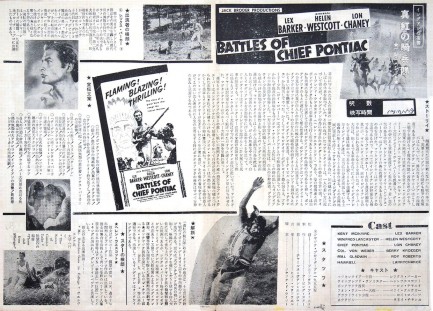


 Intimidating movie poster Mickey.
Intimidating movie poster Mickey. Not very intimidating movie Mickey.
Not very intimidating movie Mickey.



 entitled "An Interlude Before Evening," and involved being helped from her clothing by her maid Sadie before slipping nude into a bathtub. But the nudity was an illusion, the cleverest part of her act, achieved through a combination of lighting, positioning, flesh-colored underwear, and sheer athleticism as she slipped quickly from behind a towel and into the sudsy tub.
entitled "An Interlude Before Evening," and involved being helped from her clothing by her maid Sadie before slipping nude into a bathtub. But the nudity was an illusion, the cleverest part of her act, achieved through a combination of lighting, positioning, flesh-colored underwear, and sheer athleticism as she slipped quickly from behind a towel and into the sudsy tub. The trial was scheduled for early December in the Beverly Hills Courthouse. Giesler kept the jury—which wasn’t all strippers, but at least was mostly female—laughing with his continual antics. He introduced St. Cyr’s rhinestone encrusted bra and g-string as people’s exhibits A and B. He drew diagrams on a blackboard illustrating how different observers' vantage points toward the stage were blocked by St. Cyr's maid. He flustered police officials by making them discuss in detail such such terms as “bump,” “grind,” and “half-bump,” and followed that up by putting Herman Hover on the witness stand and having him demonstrate those moves. The sight of the portly Hover attempting burlesque sent ripples of laughter through the courtroom. Years later Giesler wrote: “I can honestly say I succeeded in having her case laughed into a not-guilty verdict.”
The trial was scheduled for early December in the Beverly Hills Courthouse. Giesler kept the jury—which wasn’t all strippers, but at least was mostly female—laughing with his continual antics. He introduced St. Cyr’s rhinestone encrusted bra and g-string as people’s exhibits A and B. He drew diagrams on a blackboard illustrating how different observers' vantage points toward the stage were blocked by St. Cyr's maid. He flustered police officials by making them discuss in detail such such terms as “bump,” “grind,” and “half-bump,” and followed that up by putting Herman Hover on the witness stand and having him demonstrate those moves. The sight of the portly Hover attempting burlesque sent ripples of laughter through the courtroom. Years later Giesler wrote: “I can honestly say I succeeded in having her case laughed into a not-guilty verdict.” 
 see the outline of her “private parts,” which he discerned in enough detail to determine “were shaven.” The inconsistencies were epic. Some said she caressed herself, others weren’t sure. Another described her towel as “about twenty, twenty-four inches.” In reality it was three times that size. It was as if St. Cyr's dance had dumbfounded the cops.
see the outline of her “private parts,” which he discerned in enough detail to determine “were shaven.” The inconsistencies were epic. Some said she caressed herself, others weren’t sure. Another described her towel as “about twenty, twenty-four inches.” In reality it was three times that size. It was as if St. Cyr's dance had dumbfounded the cops.
 freed her to inhabit different characters. Despite her assertions that she always wore at least a g-string and bra, she definitely performed topless on occasion, as shown by the above photo taken at Ciro’s during early 1951.
freed her to inhabit different characters. Despite her assertions that she always wore at least a g-string and bra, she definitely performed topless on occasion, as shown by the above photo taken at Ciro’s during early 1951.


 rap in his morals trial. LaMotta was serving time for bedding a 14-year-old. Prosecutors had convinced a jury that the incident with LaMotta was a primary cause of the girl later becoming a prostitute. Confidential rides to the rescue, claiming that the girl’s father had already deflowered her, therefore LaMotta could not have had any influence on the girl’s fate. How’s that for a principled stand?
rap in his morals trial. LaMotta was serving time for bedding a 14-year-old. Prosecutors had convinced a jury that the incident with LaMotta was a primary cause of the girl later becoming a prostitute. Confidential rides to the rescue, claiming that the girl’s father had already deflowered her, therefore LaMotta could not have had any influence on the girl’s fate. How’s that for a principled stand?

























































































